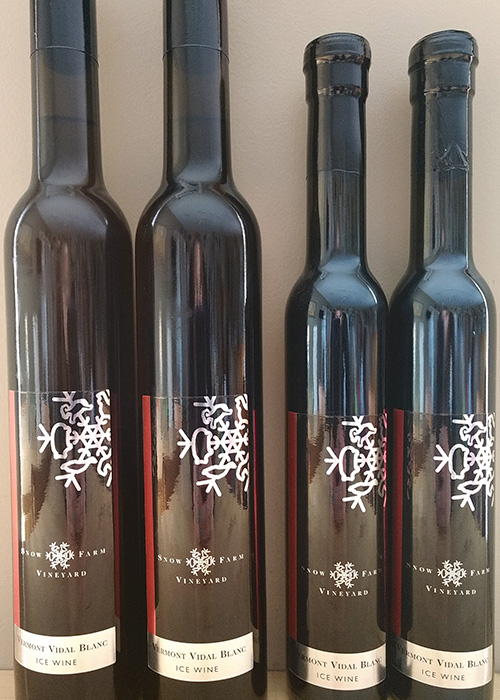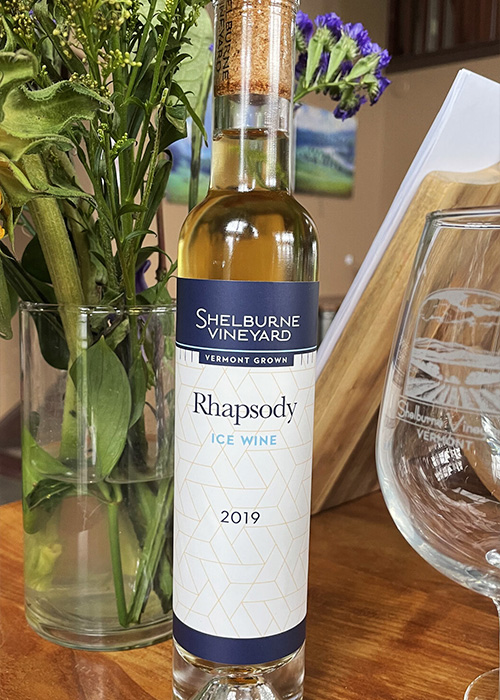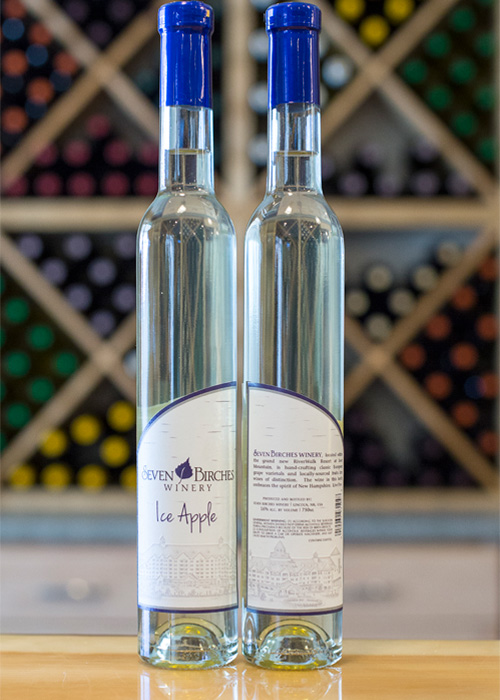VinePair is ringing in the Holiday Cheers with a spotlight on the bottles we’re gifting (and hoping to receive) and a look inside some of our favorite holiday traditions and recipes — from elevated eggnog to all things bubbly. Plus, we’ll be reflecting on the past year in the beverage industry and shifting our focus to the drinks trends we expect to see in 2022.
New England is sweet on long, snowy winters, and celebrates the season with cold weather adventures like skiing, skating, and sledding. And the icing on the fruit — for those in the know — is ice wine.
History has it that ice wine, or eiswein, was first introduced in Germany in 1830. According to the German Wine Institute, it was documented in Dromersheim and produced quite by accident — grapes froze on the vine, and farmers went ahead and picked them and made a wine that was much sweeter than previously.
Don’t miss a drop!
Get the latest in beer, wine, and cocktail culture sent straight to your inbox.
Though the institute also gives the nod to ancient Roman writer Pliny the Elder, who wrote about wine made from frozen grapes circa 44 A.D., Germany is considered the style’s contemporary forerunner, and has been for hundreds of years.
Fast forward to today: Canada has carved its place into ice wine, with Ontario leading the way as one of the world’s top ice wine-producing regions.
Among its North American neighbors, there’s New York’s Finger Lakes region. And more recently, New England has emerged as a legitimate contender in the ice wine market.
Patrick Barrelet, winemaker at Snow Farm Vineyard and Winery in Vermont and a pioneer in New England ice wine production, believes the region’s neighbor to the north has a significant advantage. “Ontario produces a lot of it with wineries like Inniskillin who popularized it in the 1990s,” Barrelet says. Additional Ontario producers Pillitteri Estates and Reif Estate Winery are among the top producers. Now, Vermont, Maine, and even New Hampshire are edging their way into the game.

What exactly is ice wine?
Ice wine is traditionally made with late-harvested grapes that have frozen on the vine, remaining on the vine until the first frost. In the United States, this is required by government regulation; to be classified as an ice wine, the grapes must freeze while still on the vine, rather than be commercially frozen after they are removed. (In the latter case, producers cleverly pivot terminology to “iced” wine, or “icebox” wine, referring to commercial freezing.)
After the grapes have been picked, they are pressed while frozen and the water in the berries remains as ice in the press, while the juice, with a lower freezing point than water, becomes a richly concentrated must. This liquid gold, much sweeter and thicker than typical grape must, is then fermented into ice wine. For this reason, ice wine is most often categorized as a dessert wine. It’s also often pricier than a winery’s other offerings, due to its relative scarcity, requirements, and risk.
According to the German Wine Institute, the frozen grapes must be picked off the vine in the frigid early morning hours when the grapes are still frozen — before they thaw. It is a game of poker with sizable risks.
New England, especially in northern states, has a winning hand in the game — wineries embrace winter and take pride in the wines they painstakingly proudly produce — but not every year. Some years you win, some years you fold.
“Ice wine is our most expensive wine,” says Barrelet, “and the reason it’s so expensive is a lot of it is the concentration of the must, and also more waste because grapes are eaten by birds and raccoons. You end up with less grapes with a lot less juice.”
Ice wine is a producer’s poker game. Some years you win, some years you fold. When Mother Nature is in charge, it is a laborious process, but the juice is worth the squeeze.
Vermont’s Snow Farm sits pretty, way up north in South Hero, on an island in the middle of Lake Champlain. It produces a Vidal Ice Wine, a dessert wine with tastes of honey, pineapple, and other tropical fruit. It pairs well with stronger cheeses such as Roquefort and other blue cheeses, and its sweetness complements desserts such as dark chocolate.
“We benefit from a great microclimate due to the lake effect,” Barrelet says. He was also a winemaker in Quebec at Domaine des Côtes d’Ardoise (he made ice wine at the winery), and studied winemaking in Burgundy, France.
“Our region is in an area called the ice wine belt,” he says, explaining that to the north the climate doesn’t allow the grapes to ripen enough to make a good quality grape; and if you travel to the south, it often doesn’t get cold enough to freeze the grapes on the vines. Barrelet defines the ice belt as the regions closest to the Canadian and American border, including townships in the eastern Quebec region, the Niagara region, and Prince Edward County in Ontario and the Finger Lakes region in New York. It also includes Vermont and some other states and provinces, he says.
“Our first year [2002] came a little as an accident when we had Vidal grapes still on the vines,” Barrelet says. “It got very cold, very early, and we decided to make a batch. It was delicious.”
The winery has since made the ice wine regularly, although not every season.
To make an ideal ice wine, Barrelet looks for high-quality mature grapes with “some nice acidity and early cold conditions in the lower 20s or teens,” he says. “And you need to keep those grapes on the vine for a long period of time, which stresses the vines,” he says. So, in order to give the vines a rest, Barrelet will typically not make an ice wine in consecutive years. “Another reason I don’t make it every year is, sometimes I made enough for a few seasons, and sometimes the conditions are not favorable for making it.”
Barrelet is making a batch of its Vidal Ice Wine this season.

It’s a labor of love. “I wouldn’t make just ice wines, as they are hard to make and expensive also. Not everyone is into very rich sweet wines,” he says.
Tucked in northern Vermont near Burlington, and dating to 1998, Shelburne grows predominantly cold-hardy hybrid grapes. In other words, perfect grapes for ice wine.
“We have a climate for it,” says Ethan Joseph, head winegrower and minority owner. The winery has been producing ice wine for about 15 years. Once upon a time, Shelburne made a winter-hardy Vidal Blanc ice wine, but now it makes an ice wine from Arctic Riesling. “We let the grapes remain on the vine until temperatures reach 10 to 15 degrees [Fahrenheit] for several days [and] nights,” says Joseph. “We pick and press them at this temperature, which concentrates the sugars into a honey-like consistency.”
It is a luxury product with limited production, he says. The 2019 Rhapsody Ice Wine is the most recent vintage.
“Occasionally we pick the grapes early and freeze commercially to give the vines a break,” Joseph says. “However, when we do this, we do not call the product ice wine.”
Aaron and Christina Peet are a couple of Mainers who, 15 years ago, traveled west to the Center for Enology and Viticulture in Walla Walla, Wash. They arrived with a dream of becoming vintners, and eventually received the opportunity to return home to the Pine Tree State and make ice wine for Cellardoor.
Located on Maine’s coast, the winery and vineyard produces Cellardoor Winery Ice Wine, which boasts notes of pineapple, caramelized banana, and butterscotch.
“We typically leave our Frontenac Blanc and Frontenac Gris grapes on the vine for late-harvest wine,” says Christina Peet, who works as assistant winemaker with husband and winemaker, Aaron Peet. “This allows the grapes to dehydrate on the vine and turn to raisins, which concentrates the sugars so it is very sweet. If we are lucky and Mother Nature gives us cold enough temps to freeze the grapes, then we are blessed with an ice wine.”
The ice wine has notes of pineapple, caramelized banana, and butterscotch.
Maine’s midcoast doesn’t always get a freeze at the right time of year — before the grapes rot on the vines, and/or are eaten by animals – so there are no guarantees from year to year. “That is why it is so rare and special and when we do make one, why it sells out as soon as we release it,” says Peet. The 2021 harvest “was a very warm fall, and out of fear of losing the crop to rot, we ended up picking all our grapes early for our traditional-method sparkling wine program,” Peet says. So, no ice wine this year.
Fruit wine has become wildly popular in New England, and Seven Birches in Lincoln, N.H., has been crafting its “popular and coveted” Seven Birches Ice Apple Wine for five years.
“Apples are abundant in New England and having made apple wine ever since we were founded in 2010, the idea to make a more robust, more flavorful, and sweeter ice wine using the same apples was appealing,” says winemaker and owner Mark LaClair. “The timing is perfect with respect to harvest and outdoor air temperatures allowing for juice to be frozen using nature’s freezer.”
There are two ways to make ice apple wine, LaClair says. One is to let the fruit freeze on the vines, then harvest and press out the juice for fermentation. The second way, cryoconcentration, is to harvest and press the apples before they freeze, then freeze the sweet juice, let it thaw, and then remove the sweet juice and discard the excess water ice crystals left behind. In both cases the juice fermenting is higher in sugar content with much more concentrated flavors.
Seven Birches uses the cryoconcentration method, pressing the freshly picked apples into a sweet apple cider, then storing the juice in 275-gallon totes outside until frozen solid in winter — it requires long mountain winter nights and temperatures below 30 degrees, says LaClair. The totes are then brought into the winery (60 degrees) and allowed to thaw. Since the sugary sweet juice has a lower freezing point, it thaws first, leaving behind water ice crystals yet to thaw. The condensed sweet juice is drained and used to ferment into the ice apple wine.

“This cryoconcentration, in some years, removes nearly half of the water content,” says LaClair. “When you remove that much of flavorless, sugarless water, the juice used to make the wine is sweeter and more flavorful.”
The apple doesn’t fall far from the tree. LaClair says ice apple wines made in New Hampshire are relatively new, but are a traditional beverage that has been made for centuries, just a little farther north in Quebec. Note: Per Canadian regulation, the apples must be frozen on the tree in order to qualify as ice wine; in the U.S., that is not the case for apples (but is for grapes).
And, like most ice wines, it’s pricey at $18 for a 375-milliliter bottle. “By volume, it is our most expensive wine,” says LaClair. “Because we are removing nearly half of the volume of the starting fermentable liquid, we are doubling our cost to produce the finished product. It takes longer, is more involved, costs more to produce, and is higher quality than a standard apple wine. … It is well worth it.”